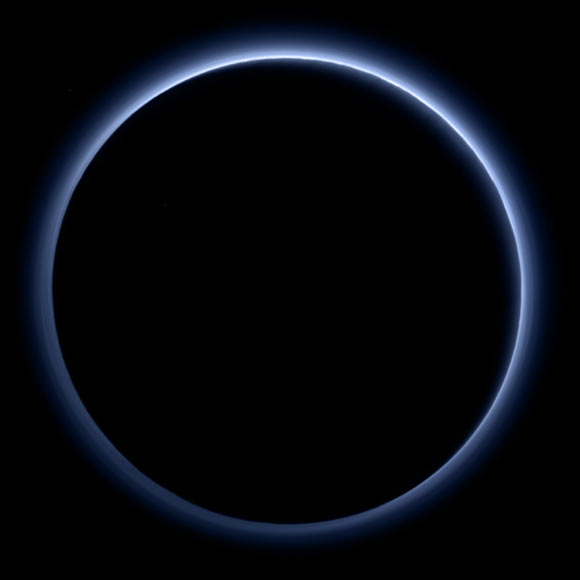The surface pressure on the dwarf planet Pluto is decreasing and that its nitrogen atmosphere is condensing, forming ice on the dwarf planet’s surface, according to a study presented this week at the 53rd American Astronomical Society Division for Planetary Sciences Annual Meeting.

Pluto’s haze layer shows its blue color in this picture taken by the New Horizons Ralph/Multispectral Visible Imaging Camera (MVIC). The high-altitude haze is thought to be similar in nature to that seen at Saturn’s moon Titan. The source of both hazes likely involves sunlight-initiated chemical reactions of nitrogen and methane, leading to relatively small, soot-like particles — called tholins — that grow as they settle toward the surface. This image was generated by software that combines information from blue, red and near-infrared images to replicate the color a human eye would perceive as closely as possible. Image credit: NASA / Johns Hopkins University Applied Physics Laboratory / Southwest Research Institute.
On August 15, 2018, Southwest Research Institute researcher Eliot Young and his colleagues observed a stellar occultation — which occurs when the light from a star is blocked by a foreground body (a planet, moon, ring, or asteroid) from reaching an observer — by Pluto.
They used the event to measure the overall abundance of Pluto’s tenuous atmosphere.
They found compelling evidence that it is beginning to disappear, refreezing back onto its surface as it moves farther away from the Sun.
“Scientists have used occultations to monitor changes in Pluto’s atmosphere since 1988,” Dr. Young said.
“NASA’s New Horizons mission obtained an excellent density profile from its 2015 flyby, consistent with Pluto’s bulk atmosphere doubling every decade, but our 2018 observations do not show that trend continuing from 2015.”
The astronomers observed a phenomenon called a central flash, caused by Pluto’s atmosphere refracting light into a region at the very center of the shadow.
When measuring an occultation around an object with an atmosphere, the light dims as it passes through the atmosphere and then gradually returns.
This produces a moderate slope on either end of the U-shaped light curve.
On August 15, 2018, refraction by Pluto’s atmosphere created a central flash near the center of its shadow, turning it into a W-shaped curve.
“The central flash seen in 2018 was by far the strongest that anyone has ever seen in a Pluto occultation. The central flash gives us very accurate knowledge of Pluto’s shadow path on the Earth,” Dr. Young said.
Like Earth, Pluto’s atmosphere is predominantly nitrogen, but unlike our home planet, it’s supported by the vapor pressure of its surface ices, which means that small changes in surface ice temperatures would result in large changes in the bulk density of its atmosphere.
Pluto takes 248 Earth years to complete one full orbit around the Sun, and its distance varies from its closest point (30 to 50 AU) from the Sun.
For the past quarter century, Pluto has been receiving less and less sunlight as it moves farther away from the Sun, but, until 2018, its surface pressure and atmospheric density continued to increase. Astronomers attributed this to a phenomenon known as thermal inertia.
“An analogy to this is the way the Sun heats up sand on a beach,” said Dr. Leslie Young, also from the Southwest Research Institute.
“Sunlight is most intense at high noon, but the sand then continues soaking up the heat over course of the afternoon, so it is hottest in late afternoon.”
“The continued persistence of Pluto’s atmosphere suggests that nitrogen ice reservoirs on Pluto’s surface were kept warm by stored heat under the surface. The new data suggest they are starting to cool.”







